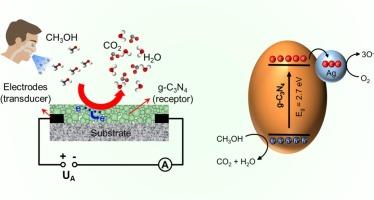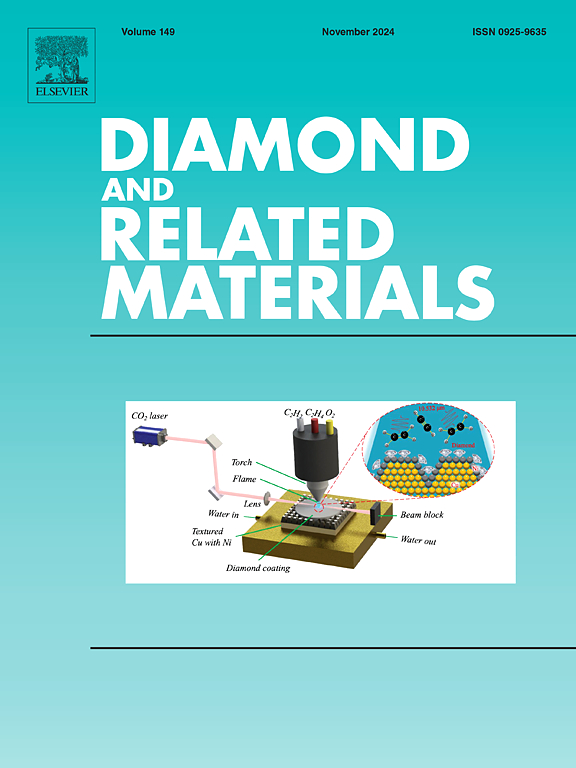Facile synthesis of silver and copper modified graphitic carbon nitride for volatile organic compounds sensing
IF 4.3
3区 材料科学
Q2 MATERIALS SCIENCE, COATINGS & FILMS
引用次数: 0
Abstract
Volatile organic compounds (VOCs) pose significant health risks when inhaled or ingested in large quantities. Metal oxide-based solid-state gas sensors are commonly utilized for VOCs detection, including methanol, however their high operating temperature and selectivity are both biggest challenges. In this context, graphitic carbon nitride (g-C3N4) has emerged as a promising alternative for VOCs sensing due to its superior sensing properties. In this work, Cu and Ag doped g-C3N4 was synthesized via the polycondensation method for VOCs sensing applications. All the samples showed a selective response to methanol at room temperature. Notably, the Ag/g-C3N4 sensor exhibited a significantly enhanced response (~27.5) compared to both undoped g-C3N4 (~3.58) and Cu/g-C3N4 (~9.82) sensors towards 200 ppm methanol. The Ag/C3N4 based sensor showed rapid response (21 s) and recovery (17 s) times, along with excellent short-term and long-term stability. It was found that Ag/C3N4 sensor exhibited a good response to humidity levels ranging from 9 % to 93 % RH, without any significant variation observed when deposited on the ceramic and flexible polyimide substrates. Further, considering its practical applicability, the Ag/C3N4 sensor showed successful detection of alcohol in human breath, highlighting its potential for real-world applications.

用于挥发性有机化合物传感的银和铜修饰石墨氮化碳的简易合成
大量吸入或摄入挥发性有机化合物(VOC)会对健康造成严重危害。基于金属氧化物的固态气体传感器通常用于检测包括甲醇在内的挥发性有机化合物,但其较高的工作温度和选择性是最大的挑战。在这种情况下,石墨氮化碳(g-C3N4)因其优越的传感特性而成为 VOCs 传感的一种有前途的替代品。本研究通过缩聚法合成了掺杂铜和银的 g-C3N4,用于 VOCs 传感应用。在室温下,所有样品对甲醇都表现出选择性响应。值得注意的是,与未掺杂 g-C3N4 传感器(~3.58)和铜/g-C3N4 传感器(~9.82)相比,Ag/g-C3N4 传感器对 200 ppm 甲醇的响应明显增强(~27.5)。基于 Ag/C3N4 的传感器显示出快速的响应(21 秒)和恢复(17 秒)时间,以及出色的短期和长期稳定性。研究发现,在陶瓷和柔性聚酰亚胺基底上沉积的 Ag/C3N4 传感器对 9 % 至 93 % RH 的湿度水平具有良好的响应,没有观察到任何明显的变化。此外,考虑到其实际应用性,Ag/C3N4 传感器成功地检测出了人体呼气中的酒精含量,突显了其在实际应用中的潜力。
本文章由计算机程序翻译,如有差异,请以英文原文为准。
求助全文
约1分钟内获得全文
求助全文
来源期刊

Diamond and Related Materials
工程技术-材料科学:综合
CiteScore
6.00
自引率
14.60%
发文量
702
审稿时长
2.1 months
期刊介绍:
DRM is a leading international journal that publishes new fundamental and applied research on all forms of diamond, the integration of diamond with other advanced materials and development of technologies exploiting diamond. The synthesis, characterization and processing of single crystal diamond, polycrystalline films, nanodiamond powders and heterostructures with other advanced materials are encouraged topics for technical and review articles. In addition to diamond, the journal publishes manuscripts on the synthesis, characterization and application of other related materials including diamond-like carbons, carbon nanotubes, graphene, and boron and carbon nitrides. Articles are sought on the chemical functionalization of diamond and related materials as well as their use in electrochemistry, energy storage and conversion, chemical and biological sensing, imaging, thermal management, photonic and quantum applications, electron emission and electronic devices.
The International Conference on Diamond and Carbon Materials has evolved into the largest and most well attended forum in the field of diamond, providing a forum to showcase the latest results in the science and technology of diamond and other carbon materials such as carbon nanotubes, graphene, and diamond-like carbon. Run annually in association with Diamond and Related Materials the conference provides junior and established researchers the opportunity to exchange the latest results ranging from fundamental physical and chemical concepts to applied research focusing on the next generation carbon-based devices.
 求助内容:
求助内容: 应助结果提醒方式:
应助结果提醒方式:


